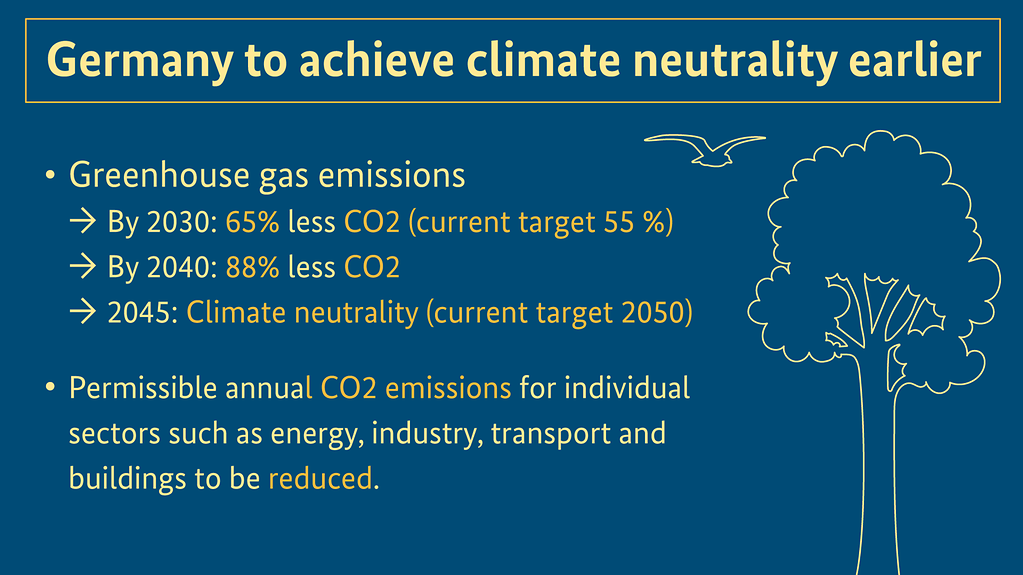Climate Change Act 2021
With the amendment to the Climate Change Act, the German Federal Government intends to tighten climate regulations and enshrine in law the goal of achieving greenhouse gas neutrality by 2045. The aim is to reduce emissions by 65 percent of 1990 levels by 2030. The Bundestag approved the amended Climate Change Act on Thursday. On Friday, it was finalised by the Bundesrat.
4 Min. Lesedauer

“The Climate Change Act provides a framework for the years and decades to come,” explains Federal Environment Minister Svenja Schulze.
Heading. Germany to achieve climate neutrality earlier
Point 1: Greenhouse gas emissions
Arrow: By 2030: 65% less CO2 (current target 55 %)
Arrow: By 2040: 88% less CO2
Arrow: 2045: Climate neutrality (current target 2050)
Point 2: Permissible annual CO2 emissions for individual sectors such as energy, industry, transport and buildings to be reduced.
Foto: Federal Government
Germany’s path to climate neutrality is laid out in the Climate Change Act. Following a ruling of the Federal Constitutional Court on 29 April, and with a view to the new European climate target for 2030, the German Federal Government presented an amended Climate Change Act 2021 on 12 May. The court ruling obliges the state to take action to prevent any future disproportionate restrictions in the fundamental liberties of today’s young generation. With the new Climate Change Act the Federal Government is confronting the particular challenges posed by climate change.
The Bundestag approved the amendment to the Climate Change Act on 24 June. On 25 June it was passed by the Bundesrat. The amendment will enter into force following promulgation in the Federal Law Gazette.
Stricter climate target by 2030
The amendment provides for raising the carbon dioxide (CO2) emission reduction targets. The target for 2030 is to be increased by 10 percentage points, to at least 65 percent. This means that by the end of the decade, Germany is to reduce its greenhouse gas emissions by 65 per cent of the 1990 levels. This even more ambitious target will impact on the CO2 reduction targets in individual sectors including energy, transport and the building sector up to 2030.
The climate goals are reviewed through continuous monitoring. Every two years, the Council of Experts for Climate Matters is going to present a report of the goals achieved, as well as measures and trends. The first report will be prepared in 2022. If budgets are not met, the Federal Government will adjust its approach immediately.
Greenhouse gas neutrality by 2045
For 2040 the reduction target is a minimum of 88 percent. Along the road to this goal, the Act lays down specific annual reduction targets during the 2030s. By 2045 Germany is to become greenhouse gas neutral. This means that there must be a balance between greenhouse gas emissions and the removal of such gases. From 2050 onward, Germany aims to have a negative emissions balance, meaning that it would then remove more greenhouse gases using natural sinks than it emits.
Strengthening natural sinks
The draft legislation stresses the contributions to the climate made by natural ecosystems. Forests and moors act as carbon sinks; they are what is termed natural sinks. They are important in order to bind remaining unavoidable emissions of greenhouse gases. The Federal Government thus specifies concrete targets in order to improve the impact of natural sinks in binding carbon dioxide.
Immediate Action Programme for more climate action
On 23 June, the Federal Government approved an Immediate Action Programme worth eight billion euros to be able to achieve the ambitious climate goals provided for by law. The goal of the programme is to intensify support for decarbonisation of the industrial sector, green hydrogen, energy-focused building refurbishments, climate-friendly mobility, as well as sustainable forestry and agriculture. The main focus is on measures that allow for short-term effects that will reduce greenhouse gas emissions visibly and verifiable..
Coordinating climate action at European level
At European level, the European Commission has still to make concrete proposals regarding measures for greater climate change mitigation. Logically, the amended Climate Change Act thus provides for an evaluation in 2022 in line with European regulations. From 2024, carbon dioxide pricing instruments are to be evaluated every two years, in line with the expected EU regulation. The goal must be to have a well coordinated mix of instruments at European and national level.
The road to climate neutrality
With the amended Climate Change Act, the Federal Government not only intends to ensure greater intergenerational justice. It will also put in place a more secure basis on which to plan. The road to climate neutrality is now set out in even more detail. Here is an overview of the milestones:
- Cabinet decision on 12 May 2021: Increase in annual reduction targets per sector for the period 2023 to 2030 and enshrining the annual reduction targets for the period 2031 to 2040 in law
- 2024: Determination of the annual reduction targets by sector for the period 2031 to 2040
- No later than 2032: Determination of the annual reduction targets for the period 2041 to 2045
- 2034: Determination of the annual reduction goals by sector for the final phase leading up to greenhouse gas neutrality (2041 to 2045)